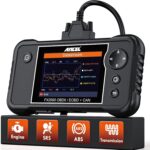Navigating the world of car diagnostics can be daunting, especially when you’re trying to pair your iPhone with a Bluetooth OBD2 scanner. The market is flooded with options, but “best” and “low cost” rarely go hand in hand. For iPhone users, compatibility adds another layer of complexity. Let’s delve into what you need to know to make an informed decision.
One of the most common and budget-friendly options is any ELM327-based OBD2 reader, often available as knockoffs. These are perfectly adequate for basic code scanning. However, it’s important to note that they typically don’t come with dedicated software. For iPhone users seeking software compatibility, online forums like this thread on bobistheoilguy.com discuss potential app solutions. While I personally own a knockoff ELM327, I rarely use it, primarily because I have access to more advanced tools like the BlueDriver and OBDLink MX+. Basic readers can help with tasks like resetting maintenance reminders – sometimes achievable through ignition key sequences or trip resets for TPMS or oil change indicators, and often through simply clearing error codes.
For a step up in diagnostic capability, the BlueDriver scanner is a significant improvement. BlueDriver not only scans codes but also provides specific repair recommendations, pinpointing likely faulty parts based on the error code and your vehicle’s make and model. This feature alone can save you time and money by guiding your repairs effectively. It’s crucial to understand that BlueDriver is exclusively compatible with its own app; it won’t work with third-party apps like Torque for Android. Although it is a more expensive option, the BlueDriver has proven its value by providing model-specific repair advice, often paying for itself over time. There are no subscription fees or hidden costs. You can even see a sample BlueDriver repair report here. Interestingly, it appears you might be able to get repair reports from the BlueDriver app even without their specific reader, by manually inputting your vehicle details and error codes – potentially making it a free resource even if you opt for a cheaper ELM327 reader.
If in-depth data monitoring is your priority, the OBDLink MX+ is an excellent choice. While BlueDriver also offers data monitoring, the OBDLink MX+ excels with a more user-friendly interface and faster data polling speeds. It also boasts enhanced diagnostic capabilities, including the ability to read manufacturer-specific error codes, which are now available for free. Previously, these advanced features were often paid add-ons or trial-based. While the OBDLink MX+ user interface still resembles a shopping cart for manufacturer-specific enhancements, accessing basic error codes and descriptions is straightforward. However, for repair solutions, you’ll typically need to research the codes further online. Like the BlueDriver, the OBDLink MX+ is a more significant investment. For a visual overview, this YouTube video offers a review of the OBDLink MX+.
It’s important to remember that these devices are primarily readers. They excel at diagnosing issues and resetting codes but are not designed to modify vehicle parameters. Both BlueDriver and OBDLink MX+ fall into a higher price bracket, around the $100 mark, but their value lies in ongoing updates for new vehicles and detailed information on error code frequency and model-specific fixes.
Keep in mind that the rapid evolution of these tools means online reviews can quickly become outdated. If you have specific questions or want to see screenshots of the apps in action, feel free to ask, especially considering the investment required without a trial period.
Finally, a crucial point for iPhone users: ELM327-based Bluetooth readers often struggle with iPhone compatibility. For reliable connectivity, consider Wi-Fi versions of ELM327 readers. Articles like this one on Medium and this Lifewire piece further explain the Bluetooth compatibility issues with iPhones and ELM327 scanners.
